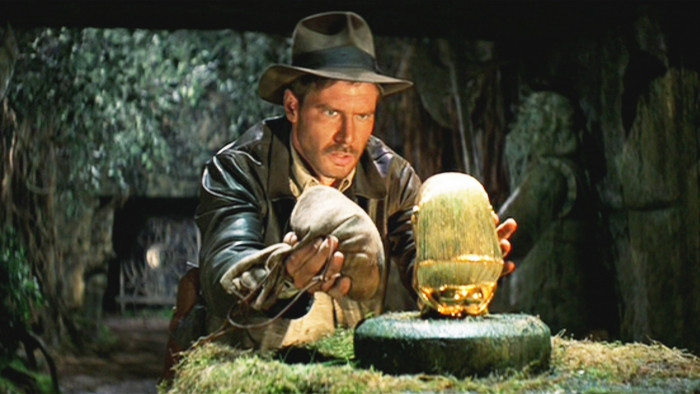We’ve all been there: you’re watching a blockbuster when someone informs you “that could never happen”. But is that always the case, asks Ross Brown.
First, for many of us, there was ET: his inspired rewiring of a Speak & Spell seemed feasible, while the airborne bike journey perfectly traversed the line between fantasy and reality. Even when we graduated to action films, the idea of one man killing an entire army with only a flick knife felt only slightly far-fetched. And sci-fi? That’s the future, and therefore anything is possible.
But one of the most distressing parts of getting older is watching a perfectly decent film and finding yourself wondering, “Would that car’s collision with that building result in that atomic bomb going off in that way?”
So as Oblivion hits the big screen, we thought it a perfect time to look at some iconic film moments and, with the help of some actual scientists, determine whether there is the vaguest chance any of them could occur.
1. COULD WE EXIST ON EARTH AFTER A NUCLEAR WAR?
Hollywood says:Definitely
In Oblivion, Tom Cruise is a marine who won the battle for Earth, and is now part of a clean-up team that has returned to mop up behind the departing earthlings.
Science says:Not without a very thick jumper
In the film, humans beat a battle against an alien invasion by turning all of the world’s 18,000 nuclear weapons on them. The good news is, we wouldn’t need them all. A mere 100 Hiroshima-sized weapons would create five million tonnes of smoke above cloud level, forming a global stratospheric screen.
“Average surface temperatures below that smoke would become colder than they have been in the past 1,000 years,” says Steve Starr, director of the Clinical Laboratory Science Programme, University of Missouri-Columbia. “The fire storms produced by nuclear war would loft 150 million tonnes of smoke into the stratosphere, blocking 70 per cent of light in the Northern Hemisphere and 35 per cent of light from the Southern Hemisphere. The prolonged cold would cause rainfall to decrease by up to 90 per cent. Growing seasons would be eliminated for more than a decade and cause most living things to die of starvation.”
Perhaps we should try a friendly handshake and cup of tea instead.
_______________________________________________________
2. COULD YOU SAFELY DETONATE A NUKE JUST OUTSIDE A MAJOR CITY?
Hollywood:Yes. Batman did it with huge success
The climax of The Dark Knight Rises sees Christian Bale’s Batman save a city by transporting a nuclear bomb a few miles out into Gotham (AKA Manhattan) bay before it explodes. What a hero.
Science says:When will the madness end?
It’s worth noting that during Operation Crossroads (the 1946 nuclear tests conducted by the Americans at Bikini Atoll), the nuclear bomb itself was detonated 90ft underwater, vaporising one ship instantly before ejecting two-million tonnes of water into the sky at 25,000ft per second, along with a huge 27,000-tonne battleship.
It also created a 29m-high tsunami and a wall of radioactive mist 6,000ft high. That bomb was 23 kilotons. So what of Batman’s?
“This is exactly why I don’t go to the cinema,” says professor of mechanical and nuclear engineering at the University of Idaho, Akira Tokuhiro. “It’s just not realistic. It’s a 225 kiloton bomb. The scale of the bomb blast would be more than 100 miles. Bombs are designed to release energy, and that energy is dissipated by all external objects to the device. Structures often just crumble from the kinetic energy of the device when it’s being transported. The entire population of the city would have been impacted.”
Oh.
_______________________________________________________
3. CAN YOU LAND ON A MOVING ASTEROID AND BLOW IT UP?
Hollywood says:Yes
Bruce Willis succeeded in Armageddon, taking a team of deep-sea drillers into space to destroy a Texas-sized asteroid before it smashed into Earth. Plenty of arguing and several thermo-nukes later, they blow it up and everyone survives. Except Bruce. (Spoiler.)
Science says:Prepare yourself for the Gravity Tractor
Firstly, you can’t actually land on an asteroid. “Low gravity is your main problem,” explains Julia Short from the UK Space Agency. “You would just keep floating away.” So it’s certain annihilation from the sky, then?
“No,” chuckles Matthew Stuttard from space transportation specialist Astrium, “we’d just build a Gravity Tractor. It works by making a small modification to an asteroid’s orbit years in advance of it impacting Earth.”
A Gravity Tractor! Or course!
“The Gravity Tractor could be positioned to fly a short distance in front of the target asteroid for about a year. The mutual gravitational attraction between the asteroid and spacecraft would slightly speed up the asteroid, causing it to miss Earth by thousands of kilometres.”
The only drawback is they need 10 years’ advance warning and still haven’t built one yet. “A spacecraft will only be funded if an asteroid is shown to be on collision course with Earth,” admits Stuttard. “But remember – the dinosaurs became extinct because they didn’t have a space programme.”
_______________________________________________________
4. WOULD MARS’ ATMOSPHERE MAKE YOUR EYES POP OUT?
Hollywood says:That’s exactly what would happen
Not only would that happen, but as soon as the atmosphere was breathable, your face would revert back to normal within six breaths. Total Recall wouldn’t lie to us, would it? Would it?
Science says:Yes, it would. You’d boil to death – in the cold
“It’s the extremely low pressure that causes nearly all of your immediate problems,” explains Dr Kevin Fong from the Centre for Altitude, Space & Extreme Environment Medicine at University College London. “The atmosphere is around 95 per cent carbon dioxide, but even if it were 100 per cent oxygen you still wouldn’t be able to breathe because the barometric pressure is so low, around one per cent of Earth’s. And the water in your soft tissue would start to boil as, with such extreme low pressures, water boils at less than 37C. It’d be cold too. Mars runs at an average of -55C.”
Yet even in the face of such pure Hollywood rubbish, Dr Fong remains upbeat. “In a film where you’re looking at transplanted consciousness, you really needn’t worry about the scientific accuracy of the bit at the end.”
_______________________________________________________
5. CAN A BITE FROM A RADIOACTIVE SPIDER CHANGE YOUR DNA (IN A GOOD WAY)?
Hollywood says:Of course it can, Stop being silly
Created by Stan Lee in 1962, Peter Parker’s Spider-Man adventures have changed over the decades, but the story of how he bagged his famed powers has always remained true: bitten by a spider.
Science says:No, but it could really damage your thyroid
Rather depressingly, Dr Anton L Brooks, professor of radiation toxicology at Washington State University, quickly rules out any chance of a radioactive spider bite turning you into a superhero, dismissing the notion out of hand with ‘facts’ and ‘logical argument’.
“Radiation is a rather poor mutagen,” he says. “And since spiders and all insects are very resistant to radiation, venom mutation on a scale to transmit superpowers to Parker is not a possible outcome.” But what if it was a really, really radioactive spider?
“OK,” sighs Brooks. “PU-239 has been called the most hazardous substance known to man. It is an alpha emitter and is not a hazard from external exposure. It is poorly absorbed through the gut so the best way to get it into the body is to be bitten by a highly contaminated radioactive spider. If a person were bitten by a spider with large amounts of PU-239, the radionuclide would locate to the liver and the bone, increasing the risk of cancer in these two organs.” Bingo!
_______________________________________________________
6. COULD YOU LAND A PLANE ON THE VEGAS STRIP?
Hollywood says:Hell, yeah. The C-123 Jailbird did it in Con Air
It was the scene that, for just a brief 10 minutes, distracted your gaze from Nicolas Cage’s ludicrous long wig. Out of fuel and out of time, Jailbird overshoots McCarran International Airport, Las Vegas and touches down on the Strip, coming to a final halt in the lobby of the famous Sands Hotel. Easy!
Science says:In your dreams
On paper it’s a dead cert: The Clark County Vegas Strip is 6.3km long, nearly 1km more than the longest airstrip in the world, Tibet’s Qamdo Bamda Airport. However, Chris Jones from the Clark County Department of Aviation is having none of it.
“The Strip is densely developed and any attempt to land an aircraft would be catastrophic. Also, the aircraft crashes through the Hard Rock Hotel sign. In fact, the Hard Rock is located about a mile east of the Strip. Looking at the film, the plane goes southbound parallel to the Strip, hits a resort located miles off the Strip, reappears back on its original setting, suddenly turns 180 degrees, then turns eastbound, then back northward again. Obviously none of that is possible. I hope that answers your question.” Yes sir.
_______________________________________________________
7. CAN YOU MAKE A LIVING AS A PENSION-AGE ELITE MERCENARY?
Hollywood says:Stallone, Arnie and Chuck Norris – in that order
In The Expendables 2, Chuck Norris works alone, somewhere deep in South America. He personally carries enough firepower to eliminate a small army. He has Stallone’s ultimate respect. Chuck Norris is 73.
Science says:It could actually happen. Really
“If Chuck has been training regularly for years, he’s likely to have slowed the ageing process significantly,” insists Dr Damien Brown, author of Band-Aid For A Broken Leg.
Meanwhile, Stallone is 66 years old and could have his own bus pass. Surely the recoil alone would pop a hip in the old man? Again, Dr Brown is adamant that this is not so. “Although their eyesight and hearing will have deteriorated to some degree, they may well have maintained a considerable level of fitness. Think of Ranulph Fiennes: at 65, he climbed Everest – still 11 years younger than the current record holder. And Britain’s Fauja Singh completed his first marathon at 89, his final one at 101.”
So there you have it: the most realistic film in this lot is The Expendables 2.
(Illustration: Jordan Cheung)
(Images: All Star and Rex Features)
Latest
Related Reviews and Shortlists


The 10 best war movies of the 21st century









